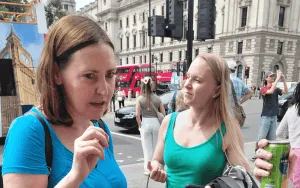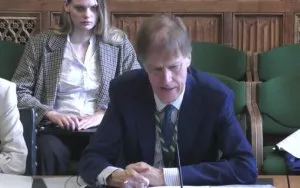Disabled People Against Cuts (DPAC) worked with German film-maker and artist Hito Steyerl on its Power Tour (pictured), which saw DPAC activists revisit the sites of six of their best-known Westminster direct actions.
Four disabled people who were unable to leave their homes to be there in person were able instead to immerse themselves in the event through “proxies” who took part in the tour and communicated with them directly and acted as their eyes and ears, using bespoke equipment and software.
The tour revisited DPAC protests such as the Circus Maximarse action in March 2015 (which targeted the Department for Work and Pensions (DWP) contractor Maximus in its first week as the new provider of the work capability assessment), last year’s universal credit “crime scene” protest, DPAC’s occupation of DWP’s Caxton House headquarters in 2012, its direct action protests inside parliament, and the 2014 occupation of the grounds of Westminster Abbey in protest at government plans to close the Independent Living Fund.
The also recreated the time activists hung underwear from a washing-line outside DWP’s headquarters as a reminder of how former work and pensions secretary Iain Duncan Smith had claimed for new underpants on parliamentary expenses.
DPAC hopes the experiment is just the latest step in the development of new technology that will allow disabled people to participate in protests remotely, if they cannot attend in person because of impairment-related reasons or a lack of support.
Two activists working with DPAC – who have been praised for their work – had designed a bespoke harness that holds a mobile phone on the chest of the proxy, so it is stable as they move around.
They have also developed software that shows a video link with the protesters, and subtitles, and which will eventually have even more advanced accessibility options.
Bob, one of the disabled people who took part remotely, said: “As someone who has helped to organise DPAC protests but has never been able to take part, being able to take part in the Power Tour was very emotional for me.
“This imaginative use of assistive technology will make it possible for more disabled people to take part in DPAC’s activities and that can only be a good thing.”
Another, Martha, said it had been “so, so lovely, thoughtful and edifying and empowering” to be included.
She said: “I look forward to more accessibility and inclusion in the future.
“It really helped me as I am disabled and have been at the receiving end of the debilitating welfare reforms… and understand what it’s been like for many like myself.”
She said her involvement meant she felt “less isolated and that I had a voice at a time when I am unable to travel and be as mobile as I would like to be.
“It felt like a burden had been lifted off me and I felt less frustrated because of the efficient, and concise, to-the-point subtitles, as I am hard of hearing.”
Marion Michell, another remote participant and an artist herself, said she had been “thrilled” to be involved from her bed.
She said: “Disabled access (to events, conferences, readings, yes, and protests too) tends to focus on those who are physically able to be in the world – remote participation for people who are housebound is rarely considered, as if we didn’t count, had nothing to contribute.
“This was a good test run, even if I had to sign off early.”
Although Michell said there were some technical problems that will need to be resolved, she said the idea of pairing a remote participant with a proxy at the event itself was “inspired”.
She said: “The personal connection made me feel more involved, not just a passive observer.
“It was great to be on the road! I want remote participation to become a default access feature. We are here!”
Paula Peters, a member of DPAC’s national steering group, said: “Going back to the sites where DPAC had its most famous actions was thought-provoking, emotional but also invigorating, seeing the participants’ feelings as we explained each action and why we mounted the campaigns we have in nine years.
“From the occupation of DWP, the washing-line of IDS underpants, the occupation of Westminster Abbey and parliament and the current fight against universal credit, it’s important to highlight the victories we had against the government, but it’s important now more than ever that we give disabled people hope and that we continue the fight for human rights and social justice.
“DPAC has an important part to play in that.”
DPAC is now looking for disabled volunteers to help develop the technology by testing it from their homes.
DPAC’s Power Tour of Westminster was carried out as part of Steyerl’s Actual Reality OS, a digital tool – hosted by London’s Serpentine Gallery – which aims to provide a visual representation of data and personal testimony concerned with power and inequality in the areas surrounding the Serpentine.
The Power Walks part of Steyerl’s project highlighted issues such as social housing and low-wage work, with DPAC’s event one of four guided walks and tours, and another led by a former artist-in-residence for Grenfell Tower that uncovered the histories of resistance and reproductive labour in north Kensington.
Steyerl worked with grassroots groups including DPAC to describe “the hidden and not so hidden inequalities from the point of view of those most affected”.
A note from the editor:
Please consider making a voluntary financial contribution to support the work of DNS and allow it to continue producing independent, carefully-researched news stories that focus on the lives and rights of disabled people and their user-led organisations.
Please do not contribute if you cannot afford to do so, and please note that DNS is not a charity. It is run and owned by disabled journalist John Pring and has been from its launch in April 2009.
Thank you for anything you can do to support the work of DNS…

 Disabled MP who quit government over benefit cuts tells DNS: ‘The consequences will be devastating’
Disabled MP who quit government over benefit cuts tells DNS: ‘The consequences will be devastating’ Minister finally admits that working-age benefits spending is stable, despite months of ‘spiralling’ claims
Minister finally admits that working-age benefits spending is stable, despite months of ‘spiralling’ claims This bill opens the door to scandal, abuse and injustice, disabled activists say after assisted dying bill vote
This bill opens the door to scandal, abuse and injustice, disabled activists say after assisted dying bill vote